The Torch coral, Euphyllia glabrescens, is a large polyp stony (LPS) coral that originates from Indo-Pacific reefs. The torch coral has long, flowing, fleshy polyps that extend from a calcified (stony) base. In moderate water flow, these corals look a bit like a torch (where they get their common name). This article will share some of the most important information to care for these awesome animals in a saltwater reef aquarium.
Table of Contents
- Quick Facts
- Introduction to Torch Coral Care
- Feeding Torch Corals
- Placement of Torch Corals in a Reef Tank
- Torch Coral Compatibility
- Reproduction: Propagation and How to Frag Torch Corals
- Anticipating Problems With Keeping Torch Corals
- For More Information
- References
Quick Facts
- Common Names: Torch, PomPom, Trumpet (Common names are sometimes challenging as other corals have similar names)
- Scientific Names: Euphyllia glabrescens (The same genus as the hammer, frogspawn, grape, and bubble corals
- Care Level: Moderately easy to keep
- Light Level: Moderate intensity
- Flow Level: Moderate
- Aggression: Aggressive; Will sting neighboring corals, with one exception – they tolerate other Euphyllia corals.
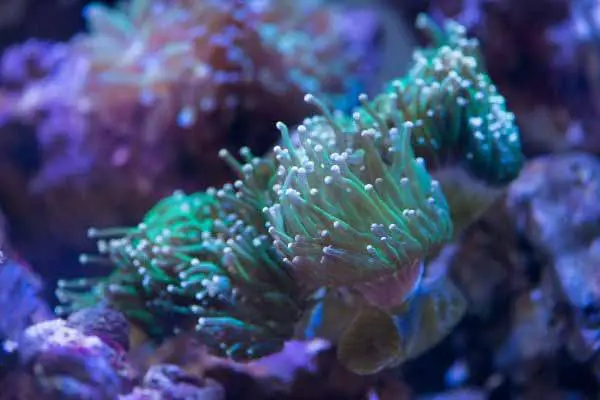
Introduction to Torch Coral Care
Torches are reported to live in a range of water conditions, from turbid (murky) to clear waters with blazingly crips light. This suggests a certain level of adaptability and ease, which is likely why these corals are great beginner corals.
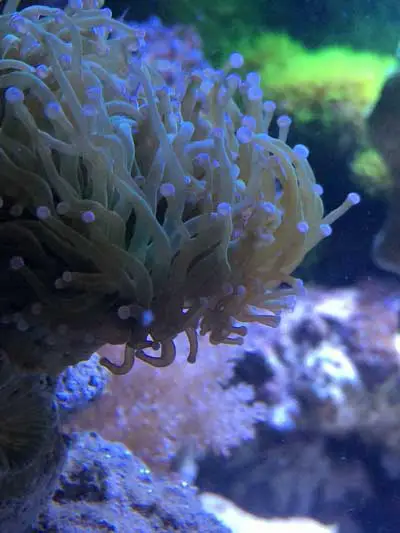
The torch coral does not have particularly challenging husbandry requirements in a reef aquarium. They require typical reef aquarium water parameters, including a temperature around 78F (25.5C), a specific gravity of about 1.025, a pH of about 8.2, and a calcium level of around 400ppm.
Like most large polyp stony (LPS) corals, a torch coral benefits from moderate water flow. The polyps remain retracted and under-inflated if the water current is too fast, as the large flowing polyps are prone to ripping and tearing.
Are torch corals easy to keep?
The torch coral is an easy-to-keep LPS coral and is generally considered a beginner coral species. They are often one of the first Large Polyp Stony species added once soft corals have been successfully kept.
Torch coral feeding
The torch coral is photosynthetic. It has a relationship with symbiotic zooxanthellae (single-cell photosynthetic organisms) that live inside its tissues. They convert light energy into sugar. In exchange for a home inside the coral, the zooxanthellae split their “harvest” and feed the coral. Therefore, it’s possible to keep torch coral without providing supplemental feeding.
However, all corals are animals, and animals are meant to eat. So while it’s technically not necessary to feed them, the fact that they biologically CAN consume rather large, meaty meals (by coral standards) suggests feeding of appropriately-sized fare is strongly encouraged.
Do Torch Corals need to be fed?
Torch corals do not need to be fed, to be kept healthy in a saltwater aquarium, but it is recommended that you feed them to boost their health and growth rate.
Want to know the proper way to feed your corals? Check out this video:
Placement of Torch Corals in a Reef Tank
The best placement for a torch coral is in a location that gets moderate water flow and moderate-intensity lighting. Just like Goldilocks, you don’t want the lights or the water flow to be too hot or too cool. You want them just right. But what does that mean?
Moderate Water Flow
Well, the fringes/corners of your tank (unless next to a powerhead or light source) are likely sites of lower flow and light within your tank. Conversely, the areas directly in front of your powerheads or gyre pumps are areas of the highest flow.
Moderate flow is achieved when the polyps are fully extended and gently swaying, as if in a breeze. NOT still or bending like in a storm (you’re not creating a hurricane), but swaying in a breeze.
Moderate Light Intensity
The upper areas of live rock (high in the tank) and areas most centrally located under your LEDs have the highest light intensity. Assuming you have high-quality reef LEDs, metal halides, or T5s, those areas are best reserved for the light-hungriest corals (certain SPS and those corals with the brightest colors. Although that’s a loose rule of thumb).
The best placement for your torches would be the middle-to-lower ends of the tank. Then they’re still in reasonably bright light but not straight under the most intense section.
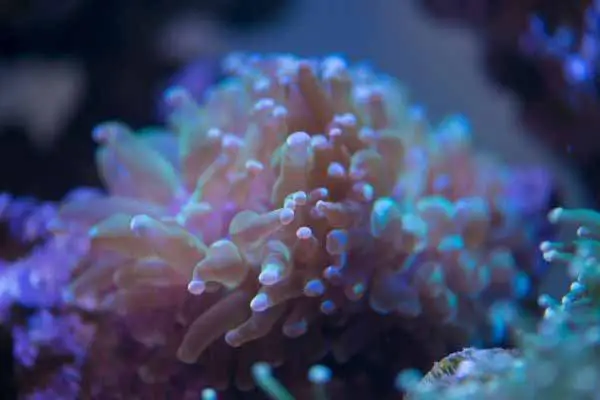
Meet in the Middle
Therefore, the best place in your aquarium is where the lighting and water flow hit that “moderate” meeting place. This may be anecdotal, but I’ve observed these corals staying happier when placed in sand versus getting glued at a mid-level on a live rock aquascape. (You can take that observation with a grain of reef salt)
Torch Coral Compatibility
Torch corals are compatible with just about any reef-safe saltwater fish that won’t consider it food.
When keeping them with other corals, give them a wide birth. Torches are aggressive corals that protect themselves by wielding their sweeper tentacles maliciously. Sweeper tentacles are specialized structures that extend further than typical tentacles and are equipped with nematocysts (stinging cells). Torches will send out these long tendrils to zap anything nearby. Because of this, you should take care to ensure that your torch coral has enough room – both now and in the future (say, once the corals in your tank have begun to fill in the available space).
Can you put Torch Coral next to each other?
Torch coral can be safely placed next to other torch coral, hammer coral, frogspawn and grape corals. They are part of the Euphyllia genus, and while they may try to sting and kill neighboring corals that grow a little too close for comfort, they will grow very well next to hammer and frogspawn corals.
A Note About Leather Corals
As a general rule, caution should be used when mixing leather corals and LPS species, such as torches. This is because many leather coral species produce and release toxic chemicals, called terpenes, into the water to protect themselves and stunt other species’ growth.
A few sections have died back on the torch coral specimen shown below. This is likely due to a combination of starvation/insufficient light and chemical warfare between other coral species in the tank.

Reproduction: Propagation and How to Frag Torch Corals
Since Euphyllia glabrescens is a branching stony coral species, it is fairly easy to propagate via fragging. You can cut, saw, or snap off a branch, and it will grow into an entirely new colony on its own.
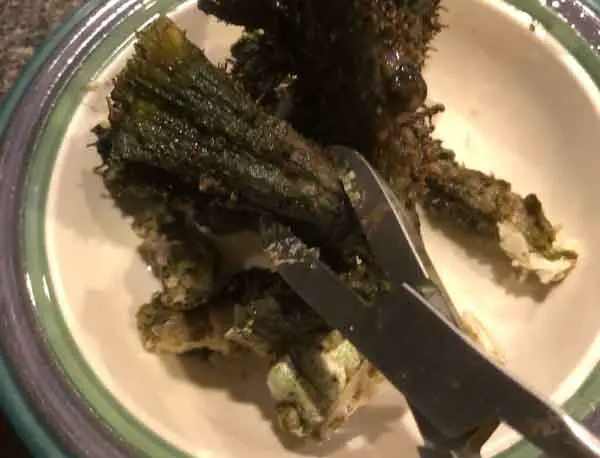
The idea of breaking off pieces of your prized coral has scared off more than a few aquarists. Hopefully, this article will give you a little confidence. The fact that corals, like this one, can reproduce entirely new, genetically identical colonies is a marvel of nature. The parent colonies respond well. You can prune your colonies to keep them looking in tip-top shape and trade frags to your local fish store or with hobbyists in the area to expand your collection and make some money on the side.
A great reference to have if you want to learn about fragging corals is the book, How to Frag Corals. It’s available on Amazon and iTunes.

Anticipating Problems with Keeping Torch Corals
One of the biggest problems I’ve seen beginner aquarists have is failing to account for the calcium demand of these corals. If there is insufficient calcium in your aquarium water, torch corals will not build their coral skeleton.
You should also never lift a torch coral out of the water if you can avoid it. You could tear the polyps. Torn polyps are prone to infection, followed by necrosis (a complete deterioration of tissue).
Signs of Problems
An unhealthy torch coral will have contracted polyps that eventually recede and turn into brown goo. This leaves behind an uncolonized coral skeleton.
A coral with sustained damage to the large fleshy polyps may get a brown jelly infection (Yes, it looks as gross as it sounds). You should move that individual to quarantine the infected branches right away. Then frag the healthy branches to save the colony.
Torch Coral Polyps Not Opening
If you have a problem with torch coral polyps not opening, you need to troubleshoot to properly identify the problem.
The first step is to confirm if anything has changed
- Are your powerheads in the same place, generating the same flow?
- Are your water parameters pristine?
The only way to know what to fix is to test the water parameters and be completely, transparently, 100% totally honest about the results.
I will confess that there are times when I fall behind in the maintenance of my tanks and water conditions suffer. Whatever you do – if you’re in a Facebook group or forum – don’t make things harder by not telling the truth about your water parameters. That’s a good first step.
Changes in water flow, lighting, pH, or salinity may be the culprit. You should also check to ensure nothing irritates the coral polyps, like Aiptasia anemones or a hungry fish. Fix any water parameter issues you find and ensure they’re getting flow and lighting that are not too intense or too low.
 For More Information
For More Information
Expect to pay in the neighborhood of $75-$100 for a colony with a few branches on it – and a lot more for premium colors or larger “centerpiece” sized colonies.
Watch this YouTube video to learn more about caring for the torch coral in your saltwater aquarium:
If you liked learning about the torch coral, you might also want to learn more about these amazing LPS corals:
Check out these other types of corals:
If you are just starting out on your reef tank journey, you may want to start here: How to set up a saltwater aquarium.
References
- Borneman, Eric H. Aquarium Corals. T.F.H. Publications. New Jersey 2004.
- Ulrich III, Albert B. How to Frag Corals. www.SaltwaterAquariumBlog.com Publications 2015
- Ulrich III, Albert B. The New Saltwater Aquarium Guide. www.SaltwaterAquariumBlog.com Publications 2014.
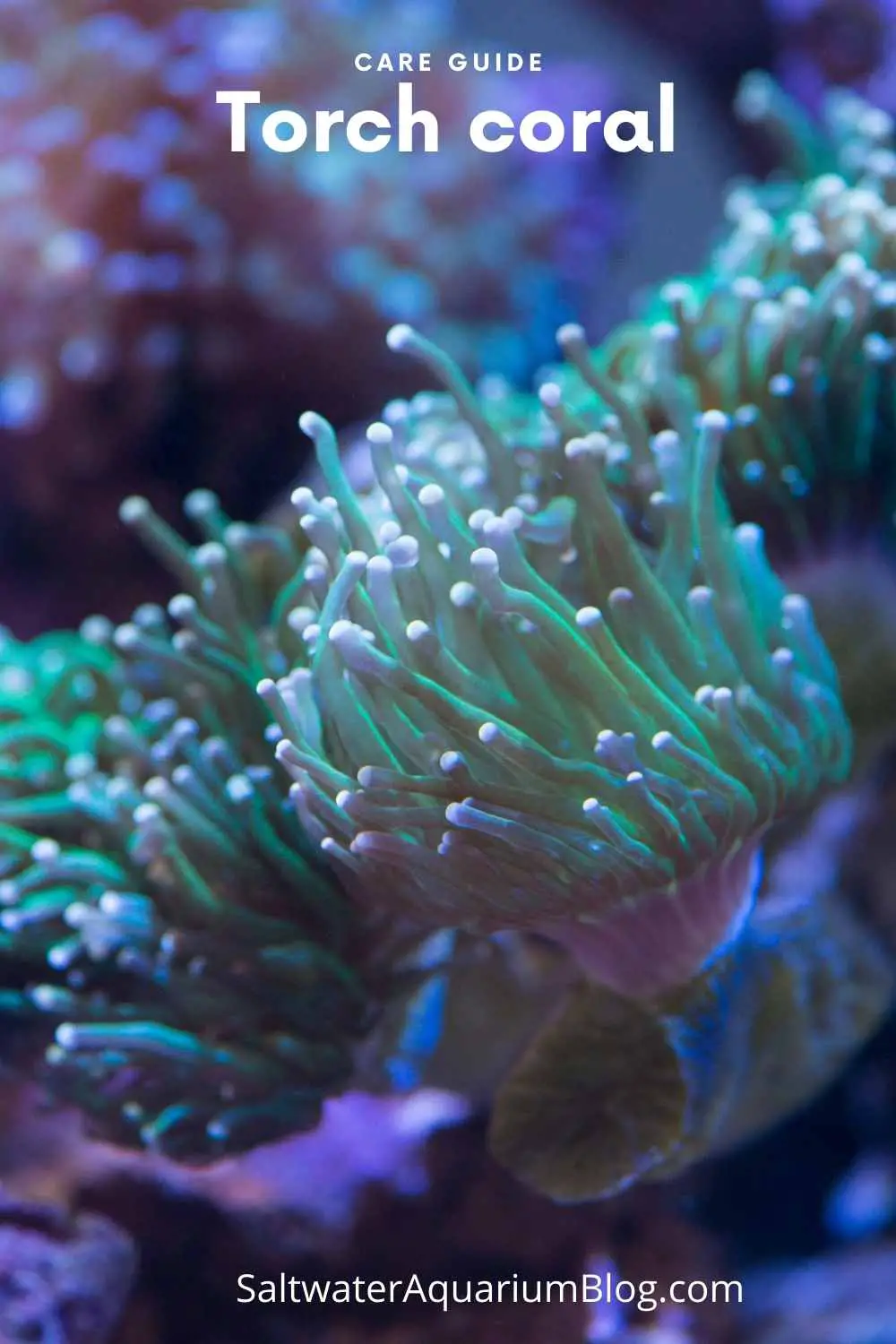
This article was written by Albert B. Ulrich III, Author of The Reef Aquarium Series of books: The New Saltwater Aquarium Guide, How to Frag Corals, 107 Tips for the Marine Reef Aquarium, and Reef Journal.
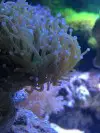
Leave a Reply